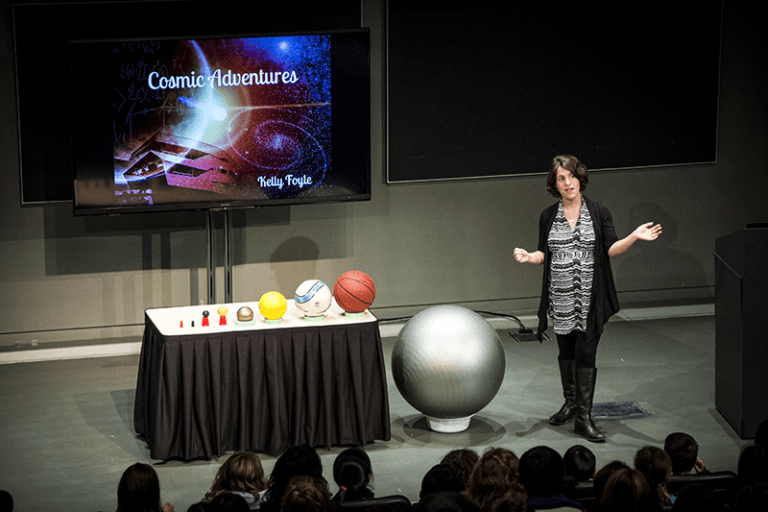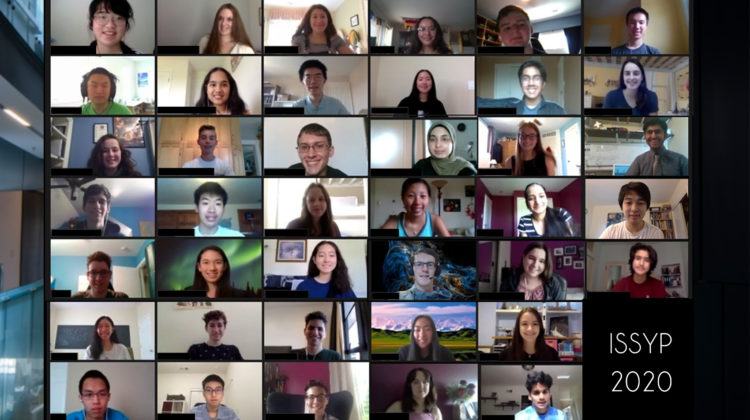Students explore the universe with Physica Phantastica
New elementary school outreach program starts with a guided tour of the cosmos.

With its intense angles, chalkboard nooks, and walls covered in equations, Perimeter Institute can feel like a science funhouse. One late-October morning, it sounded like one, too.
The Institute’s Mike Lazaridis Theatre of Ideas buzzed with excited chatter and the occasional squeal as 200 elementary students from around Waterloo Region settled in for tour of the solar system and beyond at Physica Phantastica.
Perimeter Outreach Scientist Kelly Foyle led the children through the known and into the speculative realms of cosmology, one of nine research focus areas at Perimeter.
“Eventually we get to the point where there are no more teachers to give us answers, so we have to go out like detectives and find the answers ourselves,” Foyle said.
Some things – like Jupiter’s Great Red Spot, a massive storm on that planet’s surface which humans have been watching for around 400 years, and which appears to be shrinking – are well understood.
Other things, such as the shape of the polar vortex on Saturn, are still mysteries. “We still don’t know why it has that funky hexagon shape,” Foyle told the gathering. “Maybe one of you guys will work that out.”
Perimeter holds Physica Phantastica every year, but until now it has only been for Grade 11 and 12 students.
This new event is part of a drive to reach younger students with Perimeter’s educational outreach opportunities. The Institute is also creating in-class education kits for elementary schools.
Foyle, who worked at the W.J. McCallion Planetarium in Hamilton, Ontario, before joining Perimeter in 2014, loves interacting with younger children.
“Younger grades often are more curious, and less nervous to ask questions,” she said before the one-hour event.
Adults often underestimate a child’s ability – and desire – to grapple with complex issues. That’s why Foyle designed the presentation to push beyond the solar system and into new science and tough cosmological mysteries.
Students were treated to new pictures of Saturn’s moon Enceladus, released only days before the Physica Phantastica gathering, and recent images of Pluto’s frozen-nitrogen-and-carbon-dioxide mountains, taken by the New Horizons probe.
After brief stops to “visit” the Orion Nebula (the closest stellar nursery) and the Crab Nebula, Foyle finished with black holes.
Often thought of as vacuums, these cosmic gobblers are actually more like waterfalls, she said. “If you approach (a waterfall) in a boat, you are able to turn around and go away. But once you get close enough to the edge, even with the engine at full power, you will go over. In a black hole, this is true even for light. At a certain point, even light can’t get away.”
There are 37 known black holes in our galaxy. The one at the centre – Sagittarius A* – is four million times more massive than our sun, and soon, scientists hope to get a good look at it, thanks to the Event Horizon Telescope.
“We want to take a snapshot of the edge of the waterfall,” Foyle said.
After a flurry of questions – Does the universe have an edge? What happens to an object that goes into a black hole? – the students filed out of the theatre and made their way back to school, buzzing anew at the serious fun that is physics.
– Tenille Bonoguore























































































